产品伤害危机对品牌资产的影响ppt
产品伤害危机对品牌绩效指标的影响[外文翻译]
![产品伤害危机对品牌绩效指标的影响[外文翻译]](https://img.taocdn.com/s3/m/df5c7a8351e79b8968022640.png)
毕业论文(设计)外文翻译一、外文原文标题:The effects of product-harm crisis on brand performance原文:IntroductionThe term ‘product-harm crisis’ refers to well-known events related to product defects or harm associated with some brands (Siomkos & Kurzbard 1994). For example, in 2000, when news spread that more than 100 people had died in accidents involving defective Firestone tyres, the company had to recall millions of its products (Advertising Age 2000). In September 2008, 6244 babies in China were diagnosed as suffering from numerous ailments after ingesting the poisonous Sanlu formula (People Daily 2008). Having used all of its cash reserves for product recall and medical payments, Sanlu Company was declared bankrupt in 2009. In 2005, NestléCompany mistakenly sold milk powder that contained more iodine than Chinese national standards permit in the market. When the news broke, Nestlé had to make a public apology and remove the defective product from shelves (ABC News 2005). After this crisis, in an effort to restore reduced sales, Nestlégave out samples and stationed doctors in Beijing supermarkets to deal with customers’ concerns.These examples clearly suggest that a product-harm crisis can seriously imperil a brand’s performance - and even totally destroy a company, as in the case of Sanlu. Therefore, understanding how a product-harm crisis influences brands and the market structure is of great practical and theoretical interest.The NBD-Dirichlet model (Ehrenberg 1988) is a well-established statistical model and has been extensively used to audit and predict brand performance measures (BPMs) under stationary and dynamic market structures (Ehrenberg et al. 2004). However, this model has not been used to analyse the influence of product-harm crises. Since a product-harm crisis can greatly affect brand performance, it is reasonable to assume that, by monitoring the BPMs through the product-harm crisis,we can indirectly observe how a product-harm crisis influences brands and the market structure of this product category. This approach should provide some practical benefits from a new perspective.Our main objective in this paper is to use the NBD-Dirichlet model to monitor the leading brands’ BPMs during the 2005 Nestlé product-harm crisis that occurred in China. By comparing the observed BPMs of the pre-, during and post-crisis periods to those expected, and looking at the differences between these three periods, we may come to understand how a product-harm crisis influences brands (including both crisis brand and non-crisis brands) and market structure. Limitations and managerial implications are discussed.The product-harm crisis and its influence on the brandAfter a series of product-harm crises over the years, related studies have been developed in a number of research fields. It has been widely accepted that product-harm crises have a negative influence on crisis-brand equity (Heerde et al. 2007). For example, a brand under crisis may lose its baseline sales and become more sensitive to a competitor’s market activit ies (Heerde et al. 2007). The crisis may also affect the crisis brand’s stock price (Salin & Hooker 2001). Compared to limited systematic research into crises’ market sequences, past research has focused on consumers’ and firms’ reaction towards such crise s (Dawar & Pilluta 2000).Depending on how it is conducted, most research in connection with product-harm crises can be classified into three categories. The first consists of descriptive checklists suggesting which strategies work or do not work in terms of business practices (Mitroff 2004). Because this kind of research cannot quantify the damage incurred, it can only provide limited guidance for understanding the underlying mechanisms of product-harm crises. Another stream of such research focuses on laboratory experiments. Equipped with psychological theories and different control variables, this kind of research can help us understand the moderators that play a part in influencing a product-harm crisis’s effects, and perhaps provides some valuable insights (Dawar & Pilluta 2000; Vassilikopoulou et al. 2009). However, external validity is one limitation of such research.Another research stream has recently grown in popularity, where panel data gathered during real product-harm crises have been collected and analysed using advanced mathematical models (Heerde et al. 2007; Cleeren et al. 2008). How the crisis influences the performance of the crisis brand or the affected product category can be tracked by monitoring the brand’s stock price (Salin & Hooker 2001) or sales (Heerde et al. 2007). By all accounts, this research stream provides more practical insights about the influence of the product-harm crisis.This study contributes to the third research stream in that we used the NBD-Dirichlet model to quantify the product-harm crisis’s effect on BPMs (including penetration, market share, purchase frequency and share of category requirement) and market structure during the 2005 Nestlé milk powder crisis.DiscussionThis study focused on the Nestlémilk powder crisis that occurred in China in 2005. Based on panel data from 336 families in the Beijing area, we studied the effects of a product-harm crisis on brands and market structure using the NBD-Dirichlet model. We found, first, that the market structure in the pre-crisis period was stationary. The product-harm crisis disturbed the balance, and the market during the crisis was no longer steady. As a consequence, the predictions of purchase frequencies and SCRs were not consistent with the observed measures. Four months after the outbreak of the crisis, the overall market was still not back to stationary status and there were some deviations of SCRs and purchase frequencies. This indicates that the crisis’s influence on the market still existed, and it might last for some time. However, it is interesting to point out that the observed market share and penetration seemed to match the predicted measures in all three periods. When the market was not steady in the during-crisis and the post-crisis periods, detailed data show that in most situations the observed purchase frequencies (Mengniu and Wondersun) or SCRs (Nestlé) were significantly lower than the estimated measures. This may indicate that Mengniu and Wondersun acquired some new customers from Nestlé, and these new customers did not commit heavy purchases to these brands. (This is explained in more detail in the following paragraph.) Our data also show that,among those non-crisis brands, Yili was an exception, with higher than expected SCR in both the during and post-crisis periods. In addition, the observed purchase frequencies of Yili in the during and post-crisis periods were always greater than the predicted measures, even though the difference was less than 0.3. This may relate to its market position: in both periods, Yili had the highest market share, with more than 3% margin, while its penetration was similar to that of its competitors.Second, a product-harm crisis hurts the crisis brand greatly. Our data clearly showed that the market share and penetration of Nestlé dropped significantly during the product crisis. Even though these measures recovered during the post-crisis period, they were still significantly lower than their pre-crisis levels. On the other hand, those non-crisis brands benefited from this crisis with significantly higher penetration, although our data also show a trend of returning to their pre-crisis levels. The decreased market share of Nestléredistributed to all other brands (more than 70 brands), and each of them took only a part of it. Therefore, no significant change of market share was seen in the non-crisis brands.Third, the crisis’s influence on purchase frequency and SCR of the crisis brand was not significantly different from those of the non-crisis brands. In terms of pu rchase frequency, this similarity lies in two aspects: in all three periods, Nestlé’s relative purchase frequency was always the same (significantly lower than Yili but marginally higher than the other two brands); and during the transition from the pre-crisis period to the post-crisis period, all four leading brands dropped by around0.3. Similarly, the observed SCRs of Nestlé, Mengniu and Wondersun all experienceda similar drop from the pre-crisis period to the during-crisis period, and recovered to some extent in the post-crisis period. Previous research shows that new brands garnered customer loyalty immediately after they were introduced (Ehrenberg & Goodhardt 2001). Our data further show that even a product-harm crisis will not hurt the crisis brand’s customer loyalty.Overall, Nestlé’s penetration and market share decreased dramatically, while other brands experienced an increase in penetration at the same time. Associated with this transition, the purchase frequencies and SCRs of most leading brands droppedsignificantly. Combining these observations, one reasonable explanation can be given. The product-harm crisis drove some of Nestlé’s customers away to other brands. These switched customers did not form stable purchase behaviour – in other words, they did not limit their purchases to any one special brand. These switched customers were somehow like ‘change-of-pace’ customers (Kahn et al. 1988). Even though the non-crisis brands attracted some new customers and increased their market share or penetration, the average loyalty of their new customer group was low. As a result, their purchase frequencies or SCRs became even lower. This combination of higher penetration and lower loyalty is similar to what happens to change-of-pace brands (Kahn et al. 1988) or to normal brands under deep price cuts (Bhattacharya et al. 1996).Finally, we may need to pay particular attention to Yili. Yili was special in many aspects. First, it always had the highest market share in all three periods. Second, in both the during and post-crisis periods, its observed SCRs were significantly higher than the estimated SCRs. Third, its observed SCR increased from the pre-crisis period to the during-crisis period, while all the other brands experienced SCR drop. Fourth, its observed purchase frequency always led the market with a significant margin. All these may relate to one fact – that Yili was the biggest brand in the pre-crisis market. Our research indicated that, even though all non-crisis brands benefited from Nestlé’s crisis, different brands gained differently; the most dominant brand gained more in terms of market share, even increasing SCR, while the smaller brands had smaller gains in market share and also had to sacrifice SCR. This looks like another ‘double jeopardy’ sma ller brands may have to face in reality. Interestingly, according to Heerde et al. (2007), smaller brands are more damaged than bigger brands after a product-harm crisis. Our research is consistent with that of Heerde et al. (2007) in supporting that it is always good to be a bigger brand and it is always bad to be a smaller brand.ConclusionTo the best of our knowledge, this study is one of the first attempts to apply the NBD-Dirichlet model to investigate the effects of a product-harm crisis. This paperprovides a methodology by which to assess the impact of a product crisis in a quantitative way, and applies the model to a product-harm crisis for Nestlémilk powder in the Chinese market. The research shows that this model is a great tool by which to monitor or track the development of a product-harm crisis. The modelling and estimation processes are straightforward, and the required data can easily be collected. Using this model helps us to monitor the crisis’s influence on the crisis brand, non-crisis brands and even the entire category market.Our research shows that a product-harm crisis can greatly damage the crisis brand’s market share and penetration. However, purchase frequency and SCR were not damaged at similar levels. These combined data indicate that the market was not steady, and a product crisis changed customers’ purchase behaviours. More specifically, a product-harm crisis drove away some customers of the crisis brand and these switched customers did not make up their minds about which brand to eventually switch to. The periods during and after the crisis were critical to both of the crisis brands and non-crisis brands. For crisis brands, they need to maximise their efforts to attract back this group of customers before they commit to other brands. However, for non-crisis brands, even though they had improved their market share and expanded their customer base, they should realize that this is just a temporary improvement. They need to try their best to keep these new customers satisfied, and eventually make them loyal customers. Their strategies and practices during this period will eventually affect whether they can keep these new customers.出处:Baolong Ma,Lin Zhang,Fei Li and Gao Wang.The effects of product-harm crisis on brand performance[J].International Journal of Market Research.2010.52(4), pp.443-458标题:产品伤害危机对品牌绩效指标的影响译文:介绍产品伤害危机就是一些品牌产品因存有缺陷或有害而广为人知的事件(Siomkos和Kurzbard 1994)。
CSR策略修复产品伤害危机后品牌_省略_果研究_调节变量和中介变量的作用_崔泮为
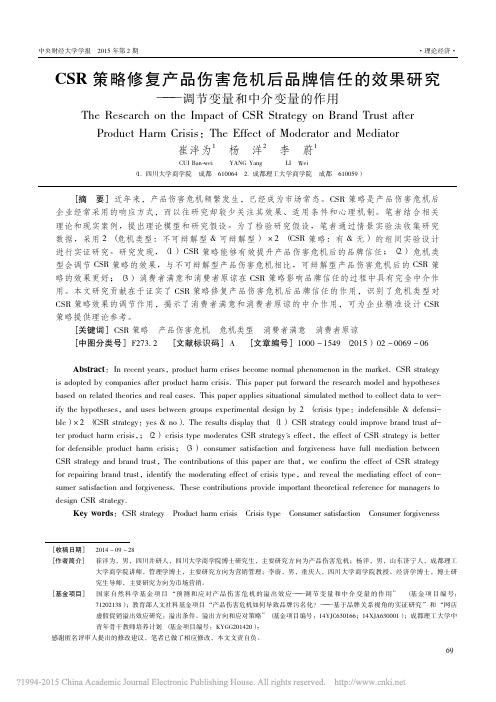
① ② ③ ④ ⑤ ⑥ ⑦ ⑧ ⑨ 瑠 瑏 瑡 瑏 瑢 瑏 瑣 瑏 瑤 瑏 瑥 瑏 瑦 瑏
Siomkos G. J. ,Kurzbard G. The Hidden Crisis in ProductHarm Crisis Management [ J] . European Journal of Marketing, 1994 ,28 ( 2 ) : 30 - 41. — —企业声誉与危机类型的调节作用 [J] . 管理世界,2010 ( 12 ) : 方正,江明华,杨洋等. 产品伤害危机应对策略对品牌资产的影响研究 — 105 - 118. 2010 ,23 ( 2 ) : 52 - 59. 张正林,庄贵军. 基于时间继起的消费者信任修复研究 [J]. 管理科学, J]. 中国流通经济, 2012 ( 1 ) : 90 - 95. 杨洋,邓富民,方正. 负面事件修复策略对品牌资产的影响 [ — —基于乳制品行业的实证分析 [J]. 农业经济问题, 2012 ( 10 ) : 84 - 92. 青平,陶蕊,严潇潇. 农产品伤害危机后消费者信任修复策略研究 — Xie Y. , Peng S. How to Repair Customer Trust after Negative Publicity: the Roles of Competence, Integrity, Benevolence, and Forgiveness [J] . Psychology and Marketing, 2009 ,26 ( 7 ) : 572 - 589. Silvera D. H. ,Meyer T. ,Laufer D. Agerelated Reactions to A Product Harm Crisis [ J] . Journal of Consumer Marketing, 2012 ,29 ( 4 ) : 302 - 309. . 商业经济与管理, 2013 ( 8 ) : 53 - 62. 涂铭,景奉杰,汪兴东. 产品伤害危机群发属性如何影响补救预期 [J] Ma B. ,Zhang L. ,Li F. ,et al. The Effects of ProductHarm Crisis on Brand Performance [J] . International Journal of Market Research,2010 ,52 ( 4 ) : 443 - 458. J] . 营销科学学报, 2008 ,4 ( 4 ) : 1 - 12. 王晓玉,晁钢令. 产品危机中口碑方向对消费者态度的影响 [ J]. 南开管理评论,2011 ,14 方正,杨洋,江明华等. 可辩解型产品伤害危机应对策略对品牌资产的影响研究: 调节变量和中介变量的作用 [ ( 4 ) : 69 - 79. Cleeren K. ,van Heerde H. J. ,Dekimpe M. G. Rising from the Ashes: How Brands and Categories Can Overcome ProductHarm Crises [ J] . Journal of Marketing, 2013 ,77 ( 2 ) : 58 - 77. J] . 经济管理, 2012 ( 8 ) : 114 - 120. 熊焰,钱婷婷. 产品伤害危机后消费者信任修复策略研究 [ Laufer D. ,Gillespie K. Differences in Consumer Attributions of Blame Between Men and Women: the Role of Perceived Vulnerability and Empathic Concern [J]. Psychology and Marketing, 2004 ,21 ( 2 ) : 141 - 157. 2006 ( 5 ) : 86 - 95. 王晓玉,晁钢令,吴纪元. 产品伤害危机及其处理过程对消费者考虑集的影响 [J]. 管理世界, Vassilikopoulou A. ,Siomkos G. ,Chatzipanagiotou K,et al. ProductHarm Crisis Management: Time Heals all Wounds? [J] . Journal of Retailing and Consumer Services, 2009 ,16 ( 3 ) : 174 - 180.
《供应链风险》PPT课件
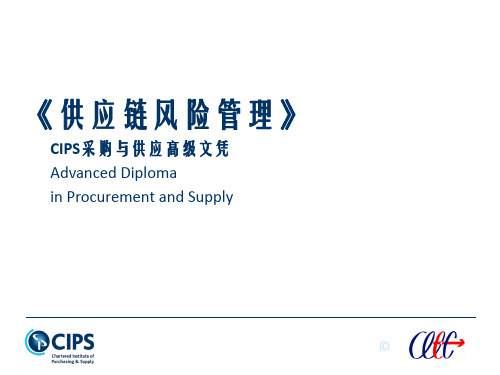
©
一般运营风险的例子
一般运营风险区域 成本结构不合理,无法降低成本基数 产品和服务需求不足(或过量)
供应商或外包提供者破产 供应中断 生产中断(例如工业罢工、设备故障引起) 健康、安全和福利问题 无效的系统、流程和管理
风险减轻措施的例子
成本分析和重组 分包或外包
提高需求预测和管理水平 改善客户关系 调整市场营销组合
加强供应商的选择、评估、监督、绩效管理
多供应源或后备供应源 灵活的和适应性强的供应链管理
预防性的和应急的规划 保险
健康与安全政策、惯例、设备、培训、保险
过程审计、基准计划、企业流程再造(BPR)或 持续改进(kaizen)
©
风险事件
• 打击(Shocks)
对组织造成创伤和瓦解的无法预知的事件。
• 危机(Crises)
预示要造成对组织及其利益相关者、声誉有重大损害或损失的重 大事件。
• 灾难(Disasters)
对组织或供应链赖以生存的基础设施造成重大损害,从而使其运 营严重中断的重大自然或人为事件。
©
风险与回报计算
• 最理想的商业机会是低风险、高回报的——但这些 机会通常是不容易获得的。
• 高风险、低回报的项目不可能有吸引力。 • 低风险、低回报的项目可能比较适合处于稳定环
境中的非常稳定的、官僚式的组织。
• 公司能够影响回报的水平和/或风险水平。
©
风险偏好
• 公司风险偏好
是指从战略层级上判断得出的合理风险总量。
©
内部风险的例子
• 人员个性因素。 • 文化价值观和行为准则。 • 团组动力学。 • 人的差错和不成熟。 • 企业管理。 • 恶意的活动。 • 技术、设备或系统崩溃。 • 安全风险。 • 缺乏内部控制。 • 工作场所危险。 • 雇员关系欠佳。 • 关键人才和知识的流失。
pptbz-biyedabian
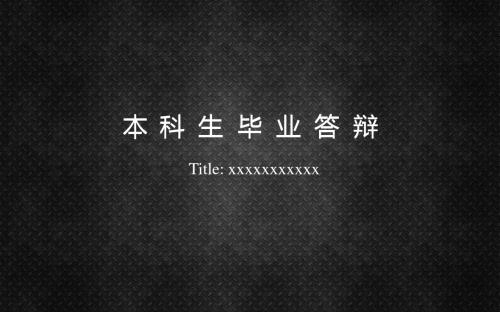
谢谢
本科 生 毕 业 答 辩
Title: xxxxxxxxxxx
模型 建立
文献 综述
实证验证 模型
结论 局限
文献 综述
Firm-based
Brand Equity
Consumerbased
文献综述
模型建立
实证研究
结论局限
Add Explanation Here
文献综述
模型建立
实证研究
结论局限
产品伤害危机对品牌资产的影响
Add Explanation Here
文献综述模型建立来自实证研究结论局限
Add Explanation Here
文献综述
模型建立
实证研究
结论局限
Add Explanation Here
文献综述
模型建立
实证研究
结论局限
jellylover PPT
文献综述
模型建立
实证研究
结论局限
篇 一 : 您 , 是 我的心 中的荷 叶 您 , 是 荷 叶。 风雨来 袭,为 我遮挡 。并给 予 我 力 量 ; 我是含 苞待放 的红莲 ,在你 的隐蔽 下吐蕊 。物理 老师, 您就是 我头顶 的 荷 叶 , 在 您的关 怀下, 我啜饮 成功的 甘醴。 中 考 前 的 物理实 验课, 您教我 们 测 电 阻 , 开关一 次次断 开闭合 ,电流 表不断 的晃动 ,手指 开始微 微颤抖 ,头上 汗 涔 涔 的 , 心里既 紧张又 着急。 正在我 手忙脚 乱不知 所措的 时候, 您不知 什么时 候 站 在 我 的 身后, 温柔的 眸子像 月光般 倾洒, 眼中满 是鼓励 ,您轻 柔的声 音缓解 了 我 的 压 力 。风儿 吹过, 传来您 身上的 淡香, 那味道 素雅却 不张扬 ,像莲 花般让 人 沉 醉 , 我 的心马 上安静 下来。 您单独 教我怎 样操作 ,我很 快完成 了实验 。看着 成 绩 单 上 的 十分, 我飞奔 出考场 ,四月 的骄阳 下,我 扑进您 的怀抱 ,和您 一起分 享 胜 利 的 喜 悦。 记 得 有 一 次 成绩单 发下来 了,看 着那令 人崩溃 的分数 ,我感 觉 天 都 塌 下 来了, 我的努 力为什 么没有 成效? 我走在 冷风中 ,阴冷 的天气 一如我 冰 冷 的 心 , 一双温 暖的手 却从背 后抱住 了我, 您细声 安慰我 :“一 次的失 败并不 代 表 永 远 的 失败, 只有在 低谷中 才能更 好地冲 向高峰 。”说 着,您 竖起大 拇指, 说 : “ 相 信 自己, 你能行 。”您 像荷叶 一样, 为我挡 住冬日 的寒冷 ,为我 注入希
品牌危机与保护讲义(PPT31张)

万科王石的捐款门
根据世界品牌实验室发布的报告,万科因为“捐 款门”事件,品牌价值比去年缩水了12.31亿。 有好事者统计,王石自1999年以来历次登山的费 用均在200万以上 。 王石说:万科对公益事业的付出是有计划的,是 经过计算的。 王老吉捐赠1亿元后超市出现断货; 关键在于万科一直在标榜自己是一个负责任的企 业,而这种标榜也为万科的品牌在很长时间内赢 得了巨大的认同。
“奶粉事件”中的雀巢,2006年“苏丹红 事件”中的亨氏…… 三鹿所谓的危机公关的背后却是谎言和一 些列的暗箱操作。一个曰金蝉脱壳,一个 曰借刀杀人。 在三鹿眼中只要搞定了政府和央视就一切 大吉了。 比毒奶粉更恐怖的其实是企业家 们集体的道德沦落!
中国企业品牌危机的根源
信心
信心
信仰
品牌保护
– 组织外部的恶意或非恶意伤害 康师傅水 – 宏观原因引起的伤害 米沙玩具熊
自然灾害--非人为原因造成的品牌危机
防范措施
全员树立危机意识 建立危机预警系统 做好品牌保护工作
筹集危机处理资源
危机处理机构工作内容
调查研究危机的历史 检测组织内信息
– 受害人:网民 正规品牌的厂商
罪状二 罪状三 罪状四
人工干预搜索结果 屏蔽不参加竞价排名网站 广告与搜索结果混淆
– 受害人:网民 正规品牌的厂商
– 受害人:网民 不参加竞价排名的企业 – 受害人的搜索体验。 新浪网进行的一项调查显示,在约5900名事件被央视曝光后,11月17日股 价应声下跌25%,市值损失14亿美元,相当于其 三年的净利 。 类似地,“3.15”期间分众传媒短信问题曝光后, 其股价从50元跌到了7元 。
启示
在举国关注的大事件中,一定要谨慎言行,
产品伤害危机理论研究综述
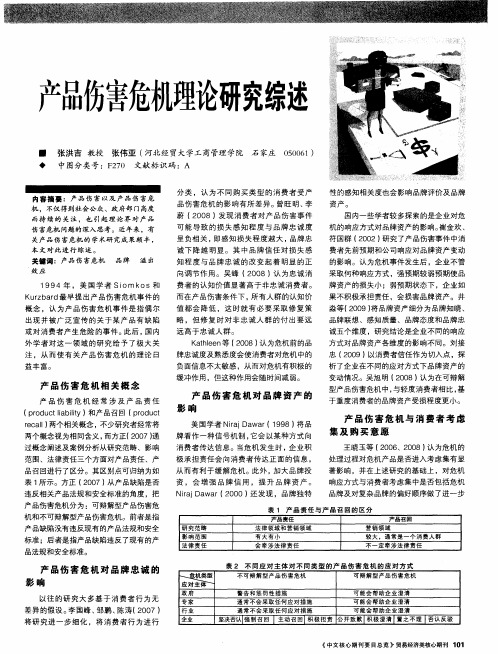
伤害危机问题的深入思考。近年来,有
关 产 品 伤 害 危机 的 学 术研 究成 果 颇 丰 ,
本 文 对 此进 行 综 述 。
可 能导 致 的损 失感 知 程度 与 品牌 忠诚 度
呈 负相关 , 即感 知损 失程度 越大 , 品牌 忠
产 品 伤 害 危 机 理 论 研 究 综 述
■ 张洪吉 教授 张伟亚 ( 河北经 贸大学工商管理 学院 石 家庄 0 5 0 0 6 1 )
◆ 中图分 类号 :F 2 7 0 文献标识码 :A
内 容 摘 要 :产 品 伤 害 以 及 产 品 伤 害 危
分 类 ,认 为不 同 购买 类型 的 消费 者 受产
从 而有利于 缓解危机 。此 外 , 加大 品牌投 资 ,会 增 强 品 牌 信 用 ,提 升 品牌 资 产 。
r e c a l 1 ) 两个相关概念 , 不少研究者经常将
两个概念 视为相同含义 , 而方正( 2 0 0 7) 通 过概 念阐述及 案例 分析从研 究范畴、影响
产 品伤 害 危 机 与 消 费 者 考 虑 集 及 购 买 意 愿
以往 的 研 究大 多基 于 消 费者 行 为无 差异的假设 。 李 国峰、 邹鹏 、 陈涛 ( 2 0 0 7) 将 研究 进一 步 细化 ,将 消费 者行 为进 行
表 2 不 同应 对 主体 对不 同类 型 的产 品伤 害 危 机 的 应对 方 式
负面信 息不太敏感 ,从而对危机有积极 的 缓; 中作用 ,但这种作用会随时 间减 弱。
变动情况。吴旭 明 ( 2 0 0 8) 认为在可辩解 型产 品伤害危机 中, 与轻度消费者相 比, 基
产品伤害危机与品牌危机概要
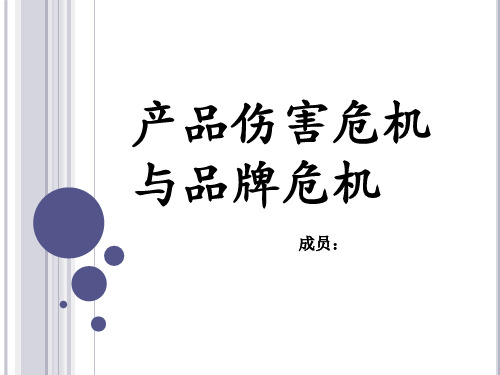
品牌危机&产品伤害危机 紧密相连 二者互为原因和结果
我国品牌危机事件(部分)
事件 雾霾天 气侵扰 多个城 市 性 后果与影响 质 区 截止到2014年1月末,我国中东部地区发生了 域 多次较大范围的雾霾天气过程。持续的雾霾 品 天气,对全国交通造成了一定的影响,同时 牌 也使得呼吸道疾病患者大量增加。这不仅影 响了人们的日常生活,还引起了全球的高度 关注。 行 山东潍坊企业将污水用高压泵排入地下 1000 业 多米,造成严重地下水源污染引起网络舆论, 品 而“企业污水直排地下”现象引起广泛关注。 牌
2.与没有危机事件比,有事件无响应会对危机 产品进入考虑集产生负面影响,并且对危机 产品在考虑集中偏好顺序也产生负面影响; 3.与有事件无响应比,企业响应、专家响应, 以及他们的双重响应会对危机产品进入消费 者考虑集产生正向影响。
2.《论不同消费群体对产品伤害危机的感知 危险差异——基于中国消费者的实证研究》 方正(2006)
4.《产品伤害危机响应方式与消费者考虑 集变动——跨产品类别的比较》王晓玉; 晁钢令;吴纪元2008
研究内容: 两次现场实验 获得在产品伤害危机过程中消费者对代表性便 利品(牙膏)和选购品(手机)的考虑集数据 检验了危机及其响应方式对消费者考虑集变动 的影响。
研究结果: 企业和专家的响应对消费者考虑集具有不同的影 响。 牙膏和手机数据的实证结果都显示 企业响应会影响考虑集中是否包括危机品牌, 而 对危机品牌在考虑集中的偏好顺序不产生显著影 响。 专家响应只能够影响到牙膏是否进入考虑集和手 机在考虑集中的偏好顺序。 企业和专家双重响应后,危机品牌在考虑集中的 偏好顺序可以恢复到危机发生前的水平,但进入 考虑集的可能性仍比危机发生前显著低。
相关概念
产品伤害危机对品牌资产的影响研究综述
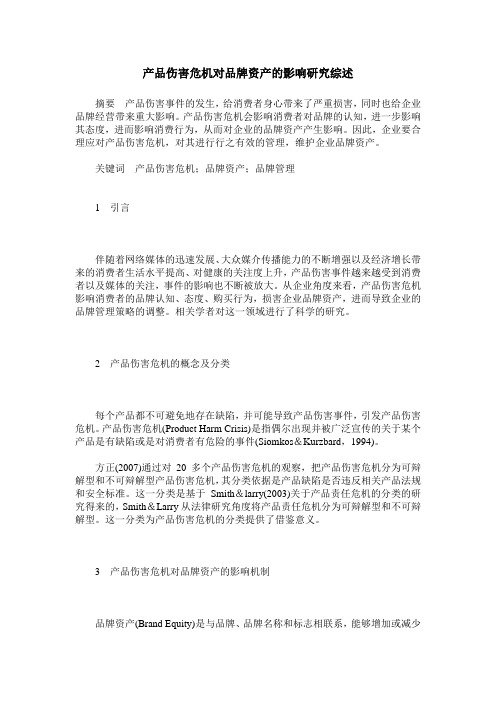
产品伤害危机对品牌资产的影响研究综述摘要产品伤害事件的发生,给消费者身心带来了严重损害,同时也给企业品牌经营带来重大影响。
产品伤害危机会影响消费者对品牌的认知,进一步影响其态度,进而影响消费行为,从而对企业的品牌资产产生影响。
因此,企业要合理应对产品伤害危机,对其进行行之有效的管理,维护企业品牌资产。
关键词产品伤害危机;品牌资产;品牌管理1引言伴随着网络媒体的迅速发展、大众媒介传播能力的不断增强以及经济增长带来的消费者生活水平提高、对健康的关注度上升,产品伤害事件越来越受到消费者以及媒体的关注,事件的影响也不断被放大。
从企业角度来看,产品伤害危机影响消费者的品牌认知、态度、购买行为,损害企业品牌资产,进而导致企业的品牌管理策略的调整。
相关学者对这一领域进行了科学的研究。
2产品伤害危机的概念及分类每个产品都不可避免地存在缺陷,并可能导致产品伤害事件,引发产品伤害危机。
产品伤害危机(Product Harm Crisis)是指偶尔出现并被广泛宣传的关于某个产品是有缺陷或是对消费者有危险的事件(Siomkos&Kurzbard,1994)。
方正(2007)通过对20多个产品伤害危机的观察,把产品伤害危机分为可辩解型和不可辩解型产品伤害危机,其分类依据是产品缺陷是否违反相关产品法规和安全标准。
这一分类是基于Smith&larry(2003)关于产品责任危机的分类的研究得来的,Smith&Larry从法律研究角度将产品责任危机分为可辩解型和不可辩解型。
这一分类为产品伤害危机的分类提供了借鉴意义。
3产品伤害危机对品牌资产的影响机制品牌资产(Brand Equity)是与品牌、品牌名称和标志相联系,能够增加或减少企业所销售产品或服务的价值的一系列资产与负债,主要包括5个方面,即品牌忠诚度、品牌认知度、品牌感知质量、品牌联想、其他专有资产(如商标、专利、渠道关系等)(D,A,Aaker,1991)。
Keller(1993)把品牌资产定义为“因顾客的品牌知识而引起的对该品牌营销活动不同的反应”,即品牌资产的产生是基于消费者头脑中对该品牌的认识。
危机对任何一个企业都存在着巨大的破坏性

产品伤害危机研究前沿危机对任何一个企业都存在着巨大的破坏性,产品伤害危机属于企业危机范畴,产品伤害危机的发生和蔓延会对企业的经营活动及品牌声誉产生不可估量的负面影响,甚至会给这个社会群体、社会和谐产生巨大的破坏效果。
例如,2014年上海福喜过期原料导致快餐供应商市场整体业绩下滑,再之前还有震荡我国乳制品行业的三鹿毒奶粉事件,这些产品伤害危机都产生了巨大的破坏效果。
随着发展,我国法律法规愈加严格,国外产品进入我国市场使得产品种类及价值更复杂,面对便捷的网络,顾客对产品质量及品牌形象的要求变的更为挑剔,媒体对企业产品伤害危机事件的报道更快更多并直接面向消费者,致使产品伤害危机被曝光地更为频繁、更严重的负面,这都会致使顾客感知风险水平增高,增多顾客抱怨行为,对品牌声誉和资产造成伤害从而影响品牌绩效,严重时甚至殃及行业内其他竞争企业。
但仍有很多企业对于产品伤害危机的认识还不够深刻,应对策略不成熟,不恰当的产品伤害危机应对策略导致许多原本不致命的危机却使得企业数几十年的努力化为泡沫。
本文总结归纳了产品伤害危机发展历程及其研究现状,帮助企业在面临产品伤害危机时能对所处情景进行更为精确的分析,提供相关建议和切实可行的办法,帮助企业选择最佳产品伤害危机应对策略,从而减少损失。
已有研究大多集中在产品伤害危机应对策略,本文的创新之处在于基于不同类型的产品伤害危机来探索其对应的应对策略,把危机进行分类具备更精准的参考价值。
此外以品牌资产为因变量,探索不同应对策略的修复效果。
本文的创新之处在于探讨了调节产品伤害危机负面影响的因素,帮助企业对症下药,同时为学术界提供了一个新的研究思路。
一、产品伤害危机及分类(一)产品伤害危机的定义产品伤害危机是指偶尔出现并被广泛宣传的关于某个产品是有缺陷或是对消费者有危险的事件(Simokos和Kurzbard,1994),这是国内学术界最多引用的概念。
例如,“三聚氰胺毒奶粉危机”、“巨能钙含致癌双氧水危机”和“光明出售回炉牛奶危机”等危机都属于产品伤害危机。
- 1、下载文档前请自行甄别文档内容的完整性,平台不提供额外的编辑、内容补充、找答案等附加服务。
- 2、"仅部分预览"的文档,不可在线预览部分如存在完整性等问题,可反馈申请退款(可完整预览的文档不适用该条件!)。
- 3、如文档侵犯您的权益,请联系客服反馈,我们会尽快为您处理(人工客服工作时间:9:00-18:30)。
可辩解型 不可辩解型
应对方式
寻找不同类型危机的最 优应对方式
对相关变量的影响
消费者购买意愿 消费者态度
消费者危险感知 消费者抱怨行为
消费者考虑集 消费者忠诚度
品牌资产
文献综述
品牌资产及其测量
产品伤害危机相关研究 产品伤害危机对品牌资产的影响
企业
关注应对方式对品牌资产的影响
早期的研究表明,产品召回不仅会造成有形的产品损失,而且还会
绪论
问题的提出
研究的目的与意义
研究的思路与方法
产品伤害危机对品牌资产影响
产品伤害 危机频发
品牌资产越 来越重要
丰田召回门 的发生
研究产品伤害危机 对品牌资产的影响
有重要意义
绪论
问题的提出
研究的目的与意义
研究的思路与方法
研究目的
研究的目的与意义
1. 建立产品伤害危机对品牌资产影响的完整分析框架; 2. 分析产品伤害危机对原品牌的影响; 3. 分析产品伤害危机对各竞争品牌的影响;
(吴旭明等,2008)
购买行为类型方面,对于采取减少失调性购买的行为、复杂购买行为、
多样化购买行为和XXXXXXXXXXXXXXXXXXXXXXXXXXXXXXX
消费者
文献综述
品牌资产及其测量
产品伤害危机相关研究 产品伤害危机对品牌资产的影响
以“丰田召回门”为例
3 实证研究
量表开发旨在发掘测量品牌资产的 四个构念的观测变量
品牌资产测量量表开发 与变量测量
正式调查与 数据截取
测量的信度与 效度检验
品牌资产的计算
结果分析
略
实证研究
品牌资产测量量表开发 与变量测量
正式调查与 数据截取
测量的信度与 效度检验
品牌资产的计算
结果分析
表1 验证性因子分析结果
信度与效度
各项拟合指标均在可接受的范围内,模型的整体拟合度良好。
注:由于卡方统计值对样本量很敏感,因此,我们主要依据以上 几个代表性拟和指标对模型效度进行评价。
Cronbach’s α XXXX XXXX XXXX XXXX
信度与效度
平均抽取方差(AVE)都大于0.7, 测量具备良好的汇聚效度 各潜变量AVE均大于该潜变量与其它潜变量的相关系数的平方, 各潜变量具有较高的判别效度
所有结构变量的α值都在0.85以上, 观测变量能够比较一致地反映结构变量
实证研究
研究的思路与方法
2 文献综述
品牌资产 的定义
Firm based
Consumer based
品牌资产 的测量
品牌资产可以分为attribute-based 和 nonattribute-based
(CHAN SU PARK and V. SRINIVASAN, 1994)
品牌资产可以分为功能性和亲和 力两大因素
产品伤害危机对品牌资产的影响ppt
1.绪论
目录
4.讨论与局限
产品伤害危机对 品牌资产的影响
2.文献综述
产品伤害危机对品牌资产的影响ppt
3.实证研究
1 绪论
产品伤害危机是指偶尔出现并被广泛宣传的关于 某个产品是有缺陷或是对消费者有危险的事件 (Siomkos & KurZbard, 1994)
品牌资产是一个产品因为其品牌名称而产生的增 加价值。
实证研究
品牌资产测量量表开发 与变量测量
正式调查与 数据截取
测量的信度与 效度检验
品牌资产的计算
结果分析
因子 Authority Identification Approval Performance
表2 量表效度与信度检验
AVE XXXX XXXX XXXX XXXX
CR XXXX XXXX XXXX XXXX
研究意义
绪论
更进一步理解产品伤害危机对品牌资产的 影响机理 为企业提供 不同的视角 应对产品伤害危机
问题的提出
研究的目的与意义
研究的思路与方法
研究思路Biblioteka 品牌资产计算 计算品牌资产及
的测量 品牌资产 相关指标的值研究方法
原品牌的
比较 行业内竞争品牌
影响 品牌资产 优劣势的变化
绪论
问题的提出
研究的目的与意义
(Morgan, 2000)
Authority Identification
Approval Performance
Brand Euqity
文献综述
品牌资产及其测量
产品伤害危机相关研究 产品伤害危机对品牌资产的影响
责任归因
责任不明情况下的 责任归因
企业声誉对归因 的影响
人口统计特征对归 因的影响
产品伤害危机相关文献
6 8-9 场座谈会
位希望在六个月内购车的消费者
300样本的预测试
因子分析和相关性分析
结合焦点访谈会的发现 并参考了大量相关文献
四个构念的测量指标
实证研究
Authority主要是借鉴了Brucks,Zeithaml和Naylor的量表 Identification参考了Grewal与Sweeney的相关量表 Approval参考了Soutar的相关量表 Performance参考了Dodds,Monroe的相关量表
(Morgan, 2000)
文献综述
品牌资产及其测量
产品伤害危机相关研究 产品伤害危机对品牌资产的影响
品牌资产可以分为attribute-based 和 nonattribute-based
(CHAN SU PARK and V. SRINIVASAN, 1994)
品牌资产可以分为功能性和亲和 力两大因素
品牌资产测量量表开发 与变量测量
正式调查与 数据截取
测量的信度与 效度检验
品牌资产的计算
结果分析
研究思路
品牌资产
计算 计算品牌资产及
的测量 品牌资产 相关指标的值
原品牌的
比较 行业内竞争品牌
影响 品牌资产 优劣势的变化
实证研究
品牌资产测量量表开发 与变量测量
正式调查与 数据截取
测量的信度与 效度检验
造成类似于品牌感知的无形资产损失
产品伤害危机及其应对方式是一种信号机制,会影响构成品牌资产
的品牌信念、品牌态度等心理因素。要传达较好的信号,保护脆弱 的品牌资产,就XXXXXXXXXXXXXXXXXXXXXXXXXXXX
消费者期望、购买行为类型等因素会影 响被产品伤害危机殃及的品牌资产
消费者对品牌的期望越高,品牌资产受损的程度就越小
品牌资产的计算
结果分析
结果分析的思路
有什么影响 影响的机理
原品牌的
比较 行业内竞争品牌
影响 品牌资产 优劣势的变化
怎样定义优 劣势
优劣势的 变化
实证研究
品牌资产测量量表开发 与变量测量
正式调查与 数据截取
测量的信度与 效度检验
品牌资产的计算
结果分析
产品伤害危机对品牌资产的影响ppt优 秀课件 精品课 件培训 课件培 训教材
